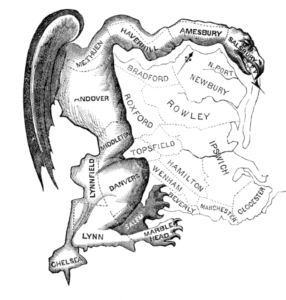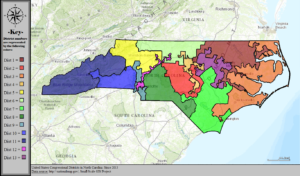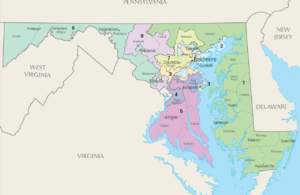Gerrymandering is the art of drawing political boundaries to benefit a particular party. The term traces its origins to early 19th century machinations of Massachusetts governor Elbridge Gerry. In 1812 the governor approved the creation of convoluted districts that benefited his party. One of the districts wrapped around the city of Boston. A particularly savvy satirist named Elkanah Tisdale thought it looked like a salamander. Tisdale dubbed the district a ‘Gerry-mander.’ Here’s Tisdale’s original cartoon from the Boston Centinal.
 The existence of gerrymandered districts represents the ultimate expression of the law of unintended consequences. In this case the root cause is the US constitution. The founders of the republic were keenly aware that the relative population among the states was a dynamic variable. So they established a ten year census. Every ten years the federal government counts every citizen in the country. Based on the results the government adjusts the number of representatives from each state. However, to preserve the powers of the states the task of drawing districts remained with the states.
The existence of gerrymandered districts represents the ultimate expression of the law of unintended consequences. In this case the root cause is the US constitution. The founders of the republic were keenly aware that the relative population among the states was a dynamic variable. So they established a ten year census. Every ten years the federal government counts every citizen in the country. Based on the results the government adjusts the number of representatives from each state. However, to preserve the powers of the states the task of drawing districts remained with the states.
Local politicians quickly recognized the power and developed four basic strategies:
- Packing concentrates as many like-minded voters as possible into a single district to create majorities in more districts by conceding a single district.
- Cracking disperses particular voters across multiple districts to deny them a majority in any single district.
- Hijacking redraws district lines such that members of the opposition party end up in the same district. Unless one moves to a new district, a risky proposition indeed, only one of them will be elected.
- Kidnapping moves a portion of an incumbent’s supporters elsewhere to make reelection more difficult.
The Supreme Court recognized the problem. However, within the framework of the constitution as long as the districts were compact, of similar populations, and continuous the court let them stand. The Voting Rights Act of 1965 changed things by allowing the court to take race into consideration (Gerrymandering was a predominant tactic to suppress minority representation). In May of 2017 the courts found that North Carolina republicans drew districts that violated the Voting Rights Act.
Here’s the North Carolina district map the court ordered redrawn (courtesy UCLA & US Interior).
Democratic led states are no better. Maryland’s democratic controlled process produced this rorschach test of a map (courtesy National Atlas of US & US Interior).
Many people on both sides of the political spectrum view gerrymandering as an existential threat to the republic.
So what’s the solution?
Of the four criteria established by the Supreme Court, compactness represents the greatest challenge and the best opportunity to thwart the practice. So how do courts objectively measure compactness and what’s the appropriate level of compactness? These are not easy questions to answer. Fortunately, specialists in probability and statistics are on the case. At this point we still have multiple solutions (link for details), but at least there’s hope. Soon we may have a solution for gerrymandering. Then again, politicians are resourceful people. So it’s only a matter of time before they find another work around.
As always thanks for reading.
Armen
Note to pay the bills: While the Warders doesn’t feature gerrymandering, there’s plenty of political intrigue built into the story. If you’re interested in a James Bond-like thriller in a fantasy setting, then, check out a summary of the series here or find links to purchase books here.



